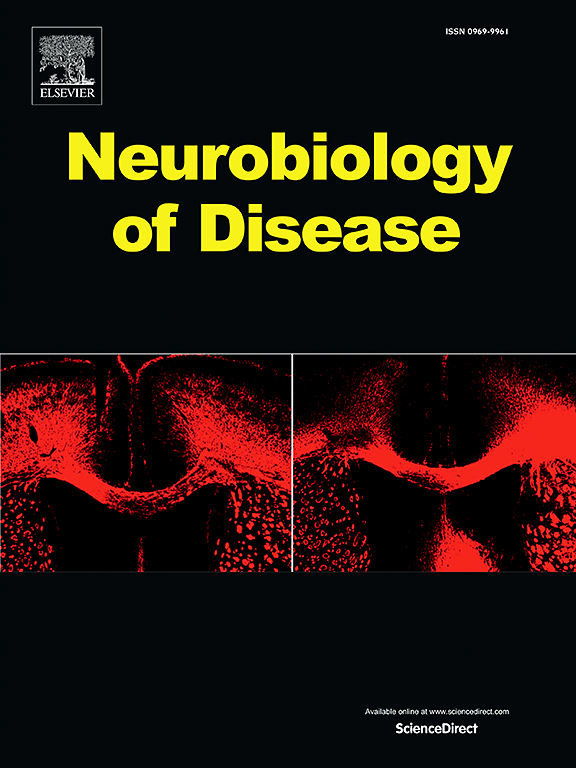DEPDC5 regulates the strength of excitatory synaptic transmission by interacting with ubiquitin-specific protease 46
IF 5.6
2区 医学
Q1 NEUROSCIENCES
引用次数: 0
Abstract
DEP-domain containing-5 (DEPDC5) is part of the GATOR1 complex that inhibits the mechanistic target of rapamycin complex-1 (mTORC1). Loss-of-function mutations in human DEPDC5 are the most common cause of lesional or non-lesional focal epilepsies associated with mTOR hyperactivation. Depdc5 silencing in mature neurons leads to excitation/inhibition imbalance and increased excitatory synapse strength. However, no link exists between mTORC1 hyperactivity and the increased activity of glutamatergic synapses. Here, we found that genetic deletion of Depdc5 in a conditional knockout (cKO) mouse recapitulates the excitatory/inhibitory imbalance observed after transient Depdc5 silencing, with increased strength of excitatory transmission and unaffected inhibitory transmission. In Depdc5 cKO neurons, the increased glutamate quantal size and response to exogenous glutamate are attributable to a higher density of GluA1-containing AMPA glutamate receptors due to a shift of the GluA1 subunit from the intracellular pool to the plasma membrane. The DEPDC5 protein interaction network included WDR48, WDR20, and USP46, a ubiquitin-specific protease that regulates GluA1, as key binding partners, along with previously established components of the mTORC1 signaling pathway. In the absence of DEPDC5, USP46 levels increase, and ubiquitination of GluA1 decreases accordingly. Either knockdown of USP46 or rapamycin treatment rescues both the increased glutamate quantal size and USP46 increase caused by Depdc5 deletion, indicating that USP46 overexpression depends on mTORC1 hyperactivity. The data indicate that the DEPDC5/mTORC1 system physiologically controls the excitatory strength by negatively modulating USP46 activity and AMPA receptor deubiquitination, and that failure of this effect can contribute to the development of the Depdc5-linked epileptic phenotype.

DEPDC5通过与泛素特异性蛋白酶46相互作用调节兴奋性突触传递的强度。
DEP-domain containing-5 (DEPDC5)是GATOR1复合物的一部分,抑制雷帕霉素复合物-1 (mTORC1)的机制靶点。人类DEPDC5的功能丧失突变是与mTOR过度激活相关的病变性或非病变性局灶性癫痫的最常见原因。成熟神经元中的Depdc5沉默导致兴奋/抑制失衡和兴奋性突触强度增加。然而,mTORC1高活性与谷氨酸突触活性增加之间不存在联系。在这里,我们发现条件敲除(cKO)小鼠的Depdc5基因缺失再现了短暂的Depdc5沉默后观察到的兴奋性/抑制性失衡,兴奋性传递强度增加,抑制性传递不受影响。在Depdc5 cKO神经元中,由于GluA1亚基从胞内池转移到质膜,导致含有GluA1的AMPA谷氨酸受体密度更高,从而增加了谷氨酸量子大小和对外源谷氨酸的反应。DEPDC5蛋白相互作用网络包括WDR48、WDR20和USP46(一种调节GluA1的泛素特异性蛋白酶)作为关键的结合伙伴,以及先前建立的mTORC1信号通路组分。在缺乏DEPDC5的情况下,USP46水平升高,而GluA1泛素化相应降低。无论是敲低USP46还是雷帕霉素治疗,都可以挽救由Depdc5缺失引起的谷氨酸量大小增加和USP46增加,这表明USP46过表达依赖于mTORC1的高活性。这些数据表明,DEPDC5/mTORC1系统通过负向调节USP46活性和AMPA受体去泛素化来生理控制兴奋强度,这种作用的失败可能导致DEPDC5相关癫痫表型的发展。
本文章由计算机程序翻译,如有差异,请以英文原文为准。
求助全文
约1分钟内获得全文
求助全文
来源期刊

Neurobiology of Disease
医学-神经科学
CiteScore
11.20
自引率
3.30%
发文量
270
审稿时长
76 days
期刊介绍:
Neurobiology of Disease is a major international journal at the interface between basic and clinical neuroscience. The journal provides a forum for the publication of top quality research papers on: molecular and cellular definitions of disease mechanisms, the neural systems and underpinning behavioral disorders, the genetics of inherited neurological and psychiatric diseases, nervous system aging, and findings relevant to the development of new therapies.
 求助内容:
求助内容: 应助结果提醒方式:
应助结果提醒方式:


